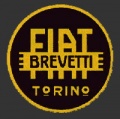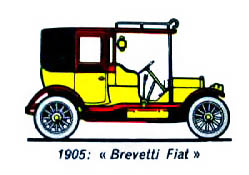Brevetti
Brevetti Fiat began officially on April, 26th 1906 from the remnants of Fiat Ansaldi. Fiat Ansaldi was in 1905 by Fiat and the Società Officine Meccaniche e Fonderie Michele Ansaldi founded and built a type 10/12 HP, which was developed at the new company Brevetti Fiat. 1909 the company was incorporated into the Fiat group and the 14-26 hp Fiat-Brevetti left the factory with just the Fiat name.
History
Although orders were satisfactory (the Ansaldi Fiat 233 were produced), about a year later, April 26 1906, the collaboration between the two companies agreed in combining: Fiat bought all activities continued production of the car Fiat Ansaldi in the same premises while Michele Ansaldi made himself available for another combination in the history of famous Italian He became as a founder of APS that is in the Society with Matteo Piemontese Automobili Ceirano.
The intake of Ansaldi, during the thirteen months of his cooperation, was purely business, while marketing and draft model of the product were in the hands of the Fiat. Together with the liquidation, the shareholders' meeting Fiat decided to change the name to Fiat Patents Company to build the new car which was used in an innovative patent: the transmission shaft.
The construction of the new Patents Fiat 10/12 HP maintained the same 3053 cc engine, but the chassis was extended several times (from 2880mm and 3020mm) in order to gain new space for the body. The car tended to be characterized hours, yet most of the former Fiat Ansaldi, as a vehicle "for tourism and services for the city" (as a presentation of 1907), with little power and great road space.
To obtain more accessible, was introduced in an unusual side-bending in the middle of the chassis was the famous case "cintre" probably French origin (it was used on contemporary Lorraine De Dietrich) through which the floor of the cars could be downgraded 7 to 10 cm of the quota allowed by the usual side-straight, superimposed on the wheels of large diameter then deployed.
In addition to a functional measure, the curvature of the side that the body then left a view, was an aesthetic very well harmonized with the design curves of the body "landaulet" which was the most widespread and made it so easily accessible to the elderly.
The car had a great success at the more conservative clientele.
It became known as the "Patents", contraction of the name and had his reputation for efficiency innovations that went in the direction of convenience, as to the transmission shaft, the clutch disc multiple oil and the exchange 4 marches (while many of the cars were still contemporary with 3 reports) plus reverse control lever side.
The rate now reached 65km/h with a consumption of 14 liters per 100km. The selling price is fixed to the remarkable figure of 18,000 lire.
The business prospered, but at the end of 1908 Fiat decides once again to put the company into liquidation.

